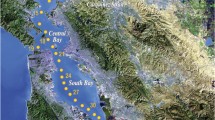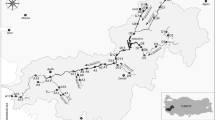Abstract
During June and July, 2002, forty-seven stations were sampled within estuaries along the gulf coast of the state of Veracruz, MX, using a probabilistic survey design and a common set of response indicators. The objective of the study was to collect information to assess the condition of estuarine waters within the state of Veracruz, and to provide data that would strengthen future assessments of Gulf of Mexico estuaries. Samples for water quality, sediment contaminants, sediment toxicity, and benthic populations were collected in a manner consistent with EPA’s National Coastal Assessment (NCA). Data were evaluated by comparing indicator measurements to tropical waters threshold values cited in US EPA’s National Coastal Condition Report II, 2004, for tropical waters. In Veracruz, 75% of the area sampled rated poor for water quality, attributed primarily to high concentrations reported for chlorophyll a, and dissolved nutrients. One percent of the area exhibited poor sediment quality, based on PAH and metals concentrations. Compared to US estuaries of the Gulf of Mexico, water quality observed in Veracruz estuaries was more affected by nutrient over-enrichment. The probabilitistic nature of the survey design allowed for the comparison of the condition of Veracruz and the US GOM estuaries.
Similar content being viewed by others
References
APICOATZA (2006). Port of Coatzacoalcos. http://www.apicoatza.com. Last visited 3/21/2006.
Commission for Environmental Cooperation. Children’s health and the environment in North America: A first report on available indicators and measures. http://www.cec.org/programs_projects/pollutants_health/children. Last visited 3/21/2006.
Diaz-Ramos, S., Stevens, D. L., & Olsen, A. R. (1996). EMAP Statistical Methods Manual. EPA/620/R-96/002. U.S. Environmental Protection Agency, Office of Research and Development, NHEERL-WED. Corvallis, Oregon.
Hyland, J. L., Balthis,W. L., Engle, V. D., Long, E. R., Paul, J. F., Summers, J. K.,et al. (2003). Incidence of stress in benthic communities along the US Atlantic and Gulf of Mexico coasts within different ranges of sediment contamination from chemical mixtures. Environmental Monitoring and Assessment, 81, 149–161.
Long, E. R., MacDonald, D.D., Smith, S. L., & Calder, F. D. (1995). Incidence of adverse biological effects within ranges of chemical concentrations in marine and estuarine sediments. Environmental Management, 19, 81.
MacDonald, D. D., Carr, R. S., Calder, F. D., Long, E. R., & Ingersoll, C. G. (1996). Development and evaluation of sediment quality guidelines for Florida coastal waters. Ecotoxicology, 5, 253–278.
Summers, J. K., Paul, J. F., & Robertson, A. (1995). Monitoring the ecological conditions of estuaries in the United States. Toxicological and Environmental Chemistry, 49, 93.
Tuxtlas.com. Laguna de Sontecomapan Region. http://www.tuxtlas.com/laguna_sontecomapan. Last visited 3/21/2006.
USEPA (1999). Ecological condition of estuaries in the Gulf of Mexico. EPA 620-R-98-004. U.S. Environmental Protection Agency. Office of Research and Development, National Health and Environmental Effects Research Laboratory, Gulf Ecology Division. Gulf Breeze, Florida.
USEPA (2001a). Environmental Monitoring and Assessment Program (EMAP). National Coastal Assessment Quality Assurance Project Plan 2001–2004. United States Environmental Protection Agency, Office of Research and Development, National Health and Environmental Effects Research Laboratory, Gulf Ecology Division. Gulf Breeze, FL. EPA/620/R-01/002.
USEPA (2001b). National Coastal Condition Report. United States Environmental Protection Agency, Office of Research and Development/Office of Water. Washington, DC. EPA-620/R-01/005.
USEPA (2004). National Coastal Condition Report II. United States Environmental Protection Agency, Office of Research and Development/Office of Water. Washington, DC. EPA-620/R-03/002.
USEPA (2006). Aquatic resource monitoring. http://www.epa.gov/nheerl/arm. Last visited 3/21/2006.
Author information
Authors and Affiliations
Corresponding author
Rights and permissions
About this article
Cite this article
Macauley, J.M., Harwell, L.C. & Alafita, H.V. The Ecological Condition of Veracruz, Mexico Estuaries. Environ Monit Assess 133, 177–185 (2007). https://doi.org/10.1007/s10661-006-9571-4
Received:
Accepted:
Published:
Issue Date:
DOI: https://doi.org/10.1007/s10661-006-9571-4




